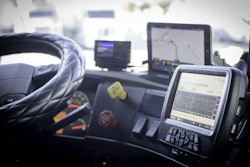 Winnipeg, Manitoba-based Bison Transport has won TCA’s Grand Prize National Fleet Safety Award nine times.
Winnipeg, Manitoba-based Bison Transport has won TCA’s Grand Prize National Fleet Safety Award nine times.How does your company approach driver safety? If you’re simply using a drivers’ Compliance Safety Accountability performance data and training them to be compliant, that’s not enough.
This was the message Garth Pitzel, Bison Transport’s director of safety and driver development, delivered during a packed educational session on creating safety cultures at the Truckload Carriers Association’s 79th Annual Convention in Nashville, Tenn.
Bison Transport, a Winnipeg, Manitoba-based truckload carrier with 1,900 drivers and 1,400 power units, has a reputation as one of the safest trucking companies in North America. It has earned TCA’s National Fleet Safety Award in the over-100-million-mile category 10 consecutive years and has taken home the Grand Prize National Fleet Safety Award nine times.
But the company’s approach to safety hasn’t always been as concrete as it has in the last decade. In the mid to late 1990s, Bison Transport’s safety culture focused solely on compliance.
With a “high” driver turnover rate of 35 percent to 40 percent during a time the company was expanding at a rate of 100 trucks per year, Pitzel said the company’s on-road safety performance fluctuated wildly. “We’d have a good year when it came to accidents and insurance, then we’d have a bad year, then we’d have a really bad year,” said Pitzel.
By 2001, unpredictable insurance and accident costs year-to-year forced management to take a closer look at its safety efforts. “We knew we had to go from being a compliant company to a safe and compliant company,” said Pitzel. “Just because you’re compliant doesn’t mean you’re safe.”
At the time, Pitzel said Bison Transport invested heavily in the development of its office personnel, but on the drivers’ side, “We gave them all the regulations and a five-day orientation and let them go, and we felt great. Thirty days later we would be re-training them.”
Working to instill a true safety culture throughout its entire organization, Bison Transport changed its entire driver training and orientation process to drive home the point that safety matters above all else.
That new vision spurred a fundamental change in how the company viewed its role in driver performance as it transitioned from driver training to skills development through a new development cycle process in 2002 that includes 12 development cycles specific to each type of driver in its operation – long-haul, city driver long combination vehicle, entry level, etc. “That was probably the best decision we made as a business because everyone learns at a different pace and has different strengths and weaknesses,” said Pitzel.
In 2005, Bison Transport also created an internal safety performance system to rate drivers by accident risk type – low, medium, high, and extreme – and target them for intervention before an accident occurs. “It was the foundation that now we could actually predict who was going to have an accident and interject with skills development,” said Pitzel. “That really has allowed us to have the consistency in our accident costs and insurance costs.”
It also developed a new policy – “The Right to Decide” – that places the responsibility of the individual to perform task safely but also gives them the authority to discontinue the task if they can’t continue to do it safely. That policy has become the foundation for the company’s newfound safety culture.
“The message to our drivers is, ‘It is our responsibility as a business to make sure you have the necessary skills to make it home every day,’” said Pitzel. “‘It is your responsibility to use those skills every day to make it home safe.’”
Four years after it began its new approach to safety, Bison won is first National Fleet Safety Award, taking home third place in its division in 2005. “That was a defining moment in our culture to help make that transition quicker,” said Pitzel. “That absolutely supported all the changes we were making in our business and became a source of pride for all our drivers.”
“We didn’t design our program to win awards, we did it to make the lives of our drivers better. And in the process, we’ve won a heck of a lot of awards,” said Pitzel with a wry smile.
“Those tremendously validate our business.”
Driver retention is perhaps as critical as any metric that affects Bison Transport’s safety performance. Today, Bison Transport’s driver turnover rate is only 20 percent. Pitzel sees a clear correlation between driver tenure and accident rates.
“If you look at drivers when they have an accident, 10 percent of them [have been with Bison] six months or less but account for 20 percent of accidents,” said Pitzel. The sweet spot [for safety performance] is 18 months to six years.”
Low driver turnover has paid huge dividends for the company, which just recognized its first driver to reach 3 million consecutive accident-free miles and its 39th driver who reached 2 million consecutive accident-free miles. To date, Bison has honored 323 drivers who reached 1 million accident-free miles.
In 2016, Bison Transport had 772 drivers win safe driving awards that accounted for 254 million consecutive safe driving miles and 708 years of safe driving for our city drivers. “That is what retention does for you,” said Pitzel.













